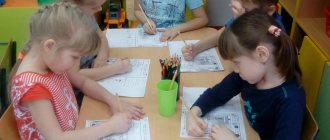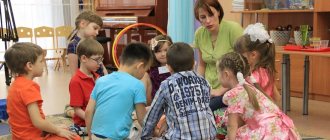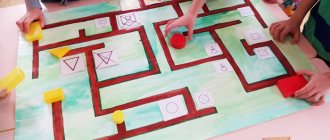Development of perception in preschool children. A person cannot live detached from the world; he feels and understands it with the help of hearing, vision, and tactile sensations. All information enters the brain and is processed efficiently. A preschooler must learn to perceive the world correctly in order to benefit from this for further development.
Features of the development of perception in a child
A preschooler perceives the world through active play, in which he learns and learns something new.
At a young age, preschool children cannot use their imagination; they use the knowledge they receive by using objects. So, if a frog is green, then for a child it can only be green. If an orange is orange, then another fruit of the same color is also an orange for the baby. Three-year-olds do not have a clear perception, they do not know how to analyze.
In the middle groups of kindergarten, pupils already have partial perception. They know colors, they know some geometric shapes, they can compare objects with each other in size and shape, but they do not understand time values. But they can and love to be creative. In many ways, getting to know the world and people for them is about accepting or not accepting appearance and character traits.
Older preschoolers already prefer to see than to hear a hundred times. Auditory perception lags behind visual perception. During this period, the child’s behavior and the qualities of his character are formed, so motivation is important when working with children of this age.
Child from one to 2 years old: perception of space and content
During this period, the child actively gets acquainted with space, since by this time he already begins to walk. Although the characteristics of objects in space still merge with their content. And starting from 1 year 2 months, a child is able to find an object by word if he has a connection between this word and the object. For example: “Give me a cube.” And by about 1 year 8 months, many words acquire a general meaning. Thus, children begin to attribute a particular word to several objects with different characteristics, and not to just one. The child is already able to distinguish a toy that is new to him and sort objects not only by color and shape, but also by more complex characteristics, for example, separating dog toys from cats. But to correctly select an object based on a word, the child still needs up to 8 repetitions.
Types of perception
A preschooler gets to know the world based on:
- visual analyzer,
- opportunity to hear
- thanks to touch.
So, with the help of hearing, a child hears speech, music, and various sounds. Sounds surround the child everywhere: at home, on the street, in kindergarten. With the help of vision, the baby evaluates the world around him, including possible danger. He also learns to love the beauty of his native land, works of art, and other beautiful things, without which a person’s life would be dull. A child's tactile abilities allow him to become familiar with the different textures of the materials around him: hot asphalt in summer or cold icicle in winter - everything matters. These tactile sensations are remembered.
Levels of development of perception in a preschooler
Perception in preschoolers has three stages.
The first is subject. Children of primary preschool age can only name objects, but are not able to characterize them.
The second is descriptive. From the age of five, preschoolers can describe what they see, compare it with something, and give an assessment.
The third stage is interpretive. Kindergarten graduates can come up with whole stories, fairy tales, supplement the story with their own feelings, and draw conclusions. He is already using the knowledge he has acquired and trying to apply his experience. This practice will be useful for children in first grade.
Exercises and games to develop perception in preschoolers
To develop perception in preschoolers, the child’s age must be taken into account. After all, what is understandable to a five-year-old will be very complex and inexplicable for three-year-olds. In particular, musical games with noise effects of natural sounds are suitable for children of middle and older groups, but not younger ones. It will also be difficult for young children to play with the shades of colors. But they will be interested in finding objects of the desired shape and specific color, and beating the rhythm. Older preschoolers can be offered complex game programs for the development of different perceptions.
Development of auditory perception
There are many sounds in the world, and each object and phenomenon has its own characteristic sound. The child must learn to understand these sounds. How the rain makes noise, how the leaves rustle, how the locomotive hums, how the birds chirp - all this is important. Toddlers do not perceive natural sounds well, but older preschoolers are already able to hear characteristic features if time is devoted to the development of auditory perception. Why is it important to learn to hear? Because without this it is impossible to speak correctly and clearly.
With kids you need to play games that develop a sense of rhythm. Sentencing handclaps are a great idea. With older children, you can already explore the sounds of nature. Walks, excursions through the forest, and the street are suitable for this.
Auditory perception is impossible without auditory attention. Therefore, you need to play “Deaf Telephone” with preschoolers, where you need to activate your hearing.
Another interesting game that children will enjoy is “Radio Theatre”. A preschooler hears a fairy tale that is read role-playing. And the child must find out which character owns the voice, intonation, and phrase.
How to develop auditory perception in children: VIDEO
Development of visual perception
At primary preschool age, children already know the names of primary colors. For them, color perception lives in four colors: red, yellow, blue and green. All other shades are unimportant. In addition, the main assessment is “beautiful” and “ugly,” and the child’s subjective opinion plays a role here.
Later, the child, recognizing new colors and learning to understand them and their shades, begins to more realistically evaluate what he sees. To develop visual perception, you can also suggest drawing a picture using dots. An interesting game will be in which the player is asked to walk through a “labyrinth”. The labyrinth is the path shown in the picture.
There may be a character on one side of the maze, and a character's goal on the other. For example, a child is asked to help a bear cub get to a barrel of honey. So, on one side of the maze there is a bear cub, on the other there is a barrel. The child must lead his finger along the drawn path, looking for the right path. It will also be useful to invite children to find the shadows of any character depicted in the picture. Attentiveness and the ability to notice little things are what this game develops.
Games to develop visual perception: VIDEO
Development of visual perception and attention in children with disabilities: VIDEO
Development of phonemic awareness
Development of perception in preschool children. Phonemic awareness includes:
- the ability to hear and identify sounds in words,
- the ability to determine where exactly a particular sound is located in a word,
- the ability to distinguish words that are similar in sound but different in meaning.
If a child knows how to do this, he will be able to learn to speak correctly, which means he will not have problems at school.
Games where children learn to recognize objects by sounds are well suited for the development of phonemic awareness. For example, a whistle whistles, cereal rustles, water makes noise, a car hums. It is also important to teach your child to hear soft and loud sounds and recognize them correctly. Another feature of phonemic perception is the understanding of the distance or proximity of sounds.
To develop phonemic awareness, the teacher often uses audio recordings with sounds of nature, and then invites children to answer what exactly they heard, offering pictures that depict various natural phenomena.
A good game would be to invite preschoolers to find out what is in the box. The box is shaken, and by the sound the children try to find out what is hidden.
To help children learn to identify the source of a sound, you can play “Bell.” In this case, the presenter places a blindfolded player in the center of the hall, and hands one of the children a bell. The child is calling. The player wearing the blindfold must indicate the direction from which the sound is coming.
Techniques for the development of phonemic hearing: sound-letter analysis in children with ODD: VIDEO
Games for developing phonemic awareness: VIDEO
Development of musical perception
Development of perception in preschool children. If very young children distinguish music by contrast, then by the age of three they already remember individual melodies they like. By the age of five, children not only sing songs, but also understand the musical mood and can distinguish the tempo of music, dynamics, duration of sounds, and rhythm. Older preschoolers are able to distinguish musical works by emotional coloring and know the terms. Children can even tell you how they feel when they hear a particular tune.
Many teachers believe that in preschool age it is useful for children to listen to classical works: N. A. Rimsky-Korsakov, P. I. Tchaikovsky, D. D. Shostakovich and others. It is also useful to introduce children to folklore. Folk dances and songs are a good opportunity not only to introduce preschoolers to folk art, but also to develop children’s musical perception.
The third step is to teach the children songs written specifically for this age. These can also be songs from children's films and cartoons. Moreover, all songs must be in genres known to children.
Development of tactile perception
Peculiarities of perception in early preschool age (3-4 years)
The perception of 3-4 year old children is characterized by specificity and lack of clarity. The main parameters of perception in early preschool age are color, shape and size. Most often, children pay attention to the most striking of these signs, and the rest of the details are guessed by them. For example, seeing buttons with numbers on the TV remote control, children often decide that it is a telephone. It is interesting that three-year-olds do not recognize even the closest people if they are dressed in carnival costumes. At this age, children clearly distinguish primary colors (red, yellow, blue, green). Little-known shades are perceived as unimportant signs, and therefore are often simply ignored. However, kids learn quickly and remember everything on the fly. The more color standards you introduce your child to, the brighter the baby’s perception will be. Sometimes children evaluate the color characteristics of objects as “beautiful” and “ugly”, so in drawing you can see the child’s color preferences, and not real images of objects.
The properties of objects for younger preschoolers are inseparable from the things themselves, so they are firmly fixed in perception. For example, a baby knows that a cucumber is always green, and can call zucchini, avocado, and green beans cucumbers.
In children of this age, their perception of space is formed through actions with objects. A 3-year-old child is just beginning to distinguish between the concepts of “far” and “close”, so he has difficulty assessing the size of distant objects. For example, looking at the panorama of the city, a child may well think that the houses are toy. To develop the baby’s spatial understanding, you need to pay his attention to his own body (the child will quickly remember that the legs are below, the head is above, and the arms are at the side), and also more often give the child requests indicating the direction (for example, “turn right” , “take the candy from the top shelf” and so on).
Methods for developing different types of perception
Here are several methods for developing perception of different types.
Size, color and shape
In this case, children are asked to take out objects of only one color from the boxes. Or suggest taking out only square objects, or only round ones. You can prepare boxes painted in different colors, and in them the child must put objects of the color in which the box is painted.
What's lost?
In this game, not only vision and attentiveness work, but also thinking. The child is asked to look at a picture showing different objects. But they are not finished yet. For example, a bicycle is missing a wheel, and a house has no windows. The child must tell what is missing.
Smell and guess
Smell works in this game. The child is blindfolded, in front of him are vegetables and fruits, and other products that the player must name, guided by smell.
Magic sound
A game that awakens the imagination and ears. Child with closed eyes. The presenter plays sounds, including the audio system: the sound of rain, the sound of a steam locomotive, the chirping of birds, etc. The child names who the sounds belong to.
Tactile riddle
There are objects in the container. The child, without looking, must determine by touch what it is. Objects must be of different sizes, shapes, smooth or rough.
Perception of children in the middle preschool period
Four and five year old children have already made some progress in the development of perception:
- basic shapes are easily recognized: circle, triangle, square, rectangle;
- know and distinguish 7 primary colors well;
- have an idea of the variability of color saturation: lighter or darker;
- know and use the division of color into warm and cold shades;
- understand soft and sharp combinations of colors.
Types and properties of perception
Peculiarities of perception of objects (phenomena)
By the age of 5, an idea of the size of objects and the ability to compare them is formed. Children of this period begin to use abstract concepts such as height, width and length when making comparisons. They can compare two or three objects relative to each other, using the concepts: “largest” and “more”, “average”.
Game for orientation in space “top-bottom, right-left”Features of the perception of time and space
The perception of these quantities takes a long time to form in children. For middle preschoolers, it only “adds up.” As a rule, children remember the basic quantities denoting time intervals (hour, minute, today, yesterday, tomorrow), but do not yet know how to use them adequately. This is understandable: time is not subject to direct manipulation, and therefore all concepts associated with its designation are relative.
Time orientation is a difficult task for 4-5 year olds
For the same reason, a 4-5 year old child is not yet able to master the system of measures: centimeter, meter, kilometer.
Features of artistic perception
During the preschool period, all children are creators. They engage in artistic creativity, modeling, appliqué a lot and with great pleasure, and are interested in various types of design. For them, artistic creativity is a way of understanding the world, the ability to perceive feelings, and give birth to experiences. Children of this period are very emotional and the opportunity to create also plays a therapeutic role for them.
Peculiarities of perception of oneself and other people
The perception of people by children at this age is distinguished by evaluative judgments related to a person’s appearance and his moral qualities. For example, children may say about the teacher: “She is always beautiful (elegant).” About people who show warm feelings towards them: “She always hugs (kisses) me,” or “She is kind and affectionate.” Children speak especially emotionally vividly about those to whom they are most attached.
At 5 years old, for a child, the mother is the most beautiful and the youngest
Children's perception of peers depends on the child's popularity in the children's society (group) and his assessment by other children. We can influence this indirectly.
Game “Color + Shape” - for kids 5-6 years old
Perception disorders and causes
Development of perception in preschool children. Perception disorders are the inability to correctly perceive surrounding sounds and objects. Such a person is disoriented; he cannot really assess the reality around him.
The causes of perception impairment may be:
- pathology of the central nervous system, including due to diseases;
- mental disorders;
- reaction to taking complex medications such as antidepressants, antivirals and others;
- drug addiction, including congenital;
- trauma resulting in damage to the nervous system;
- physical and mental fatigue of the body;
- visual defect.
A child suffering from perception disorders needs to work with specialists who will create an individual program. But at the same time, the family can help solve the problem in the following ways:
Follow a daily routine
Get up and go to bed at the same time, eliminate those actions that cause fear and emotional stress.
Light
The child does not perceive the shape and color of objects well, and in poor lighting it becomes even worse. Therefore, the light should be bright, but soft.
Colors
So that the nervous system does not experience additional stress, it is necessary that the child’s room has as little gloss and ornaments as possible and as many solid colors as possible.
Daily activities to develop perception
Games to develop the ability to understand the size, size and shape of an object, as well as its color, and to develop sound and visual perceptions should be built taking into account the characteristics of children with disabilities. For example, you can offer to play such a game. It is proposed to insert an element of the same shape into specific puzzles. Of course, the child will not succeed right away, but over time he will experience small success. You can also use games that require tactile sensations. Playing with sand is also calming and develops fine motor skills.
Perception of what it is
In psychology, perception is understood as the process of reflecting reality in all its interrelations. A person receives signals from the environment through various senses. From them, information enters the brain, where it is “processed” and “generates” sensations.
An important role in perception is played by a person’s activity, his speech and the “baggage” of accumulated life experience.
All this allows us to see not only the properties of individual objects, but also to perceive a full picture of the reality around us.
Sensory perception in young children
A person’s ability to perceive information, unlike the ability to do so, is not innate. When a child is born, he learns to do this. He sees objects, hears certain sounds, feels touch and smells. This is evidence of the formation of the perception mechanism. But the child cannot use it - he does not know how yet.
The meaning of perception
The importance of the perception process is difficult to overestimate. This is the basis of human knowledge, the foundation for its further development. Knowledge of the world begins with perception, which involves the inclusion of other mental operations: attention, thinking and memory.
That is why it is so important to know its development features and be interested in this development
A child’s understanding of the world begins with perception
What influences the development of perception in a child
Development of perception in preschool children. At preschool age, a child’s mental development is formed, and thinking begins to actively work. If any perception is “asleep,” it will be more difficult for the child to explore the world and acquire new knowledge, which means it will be more difficult for him later in school.
The development of a child’s perception is greatly influenced by his environment and the adults who are next to him. Educational games, which are used by teachers to develop perception, should not only simply reproduce some details from a child’s life, but also be informative, teach him, force him to learn more. It is the desire to know and try that becomes a kind of motor that moves the child in his development.








